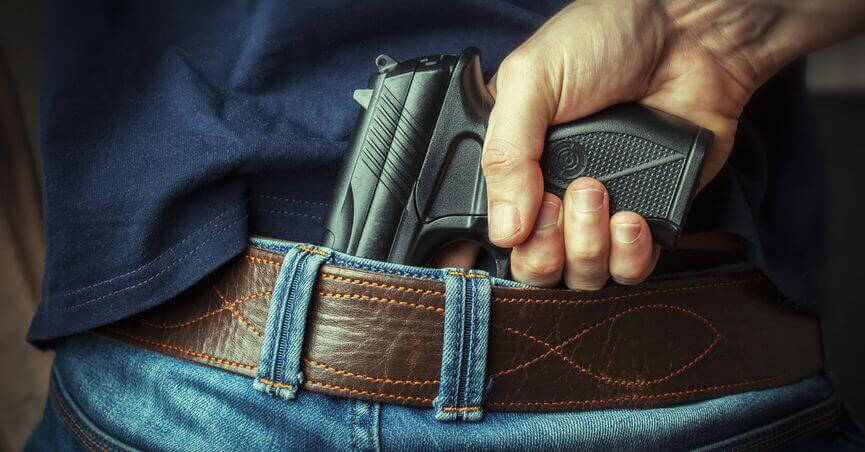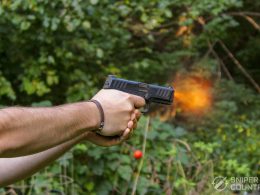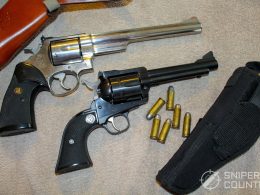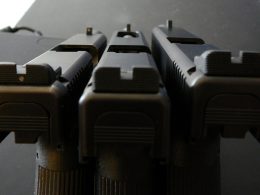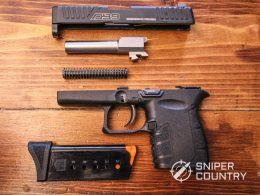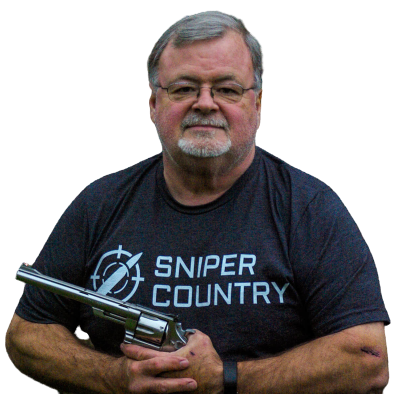In this Article:
Deer-legal in my state. Huh? The Glock 23 is deer-legal in my state. The .40 S&W shot through a minimum-4-inch barrel is considered deer medicine where I live. Add in the ability to shoot the .40 from a carbine, and the joy increases with each additional foot-pound of energy you gain with that longer barrel.
Why mention that you can waylay deer with the .40 S&W around these parts? Because it is a potent round in its own right. Its peak law enforcement usage might have been a few years ago, but that doesn’t take the shine off the pumpkin.
It is still a good man stopper and (according to my state’s deer regulations) a good deer-stopper as well. Many law enforcement agencies used (or used) the .40 S&W, most notably the FBI, for a while before they went back to the 9mm. It has lost popularity, but the .40 S&W is still very effective. Let’s take a quick look at the cartridge, then examine the gun.
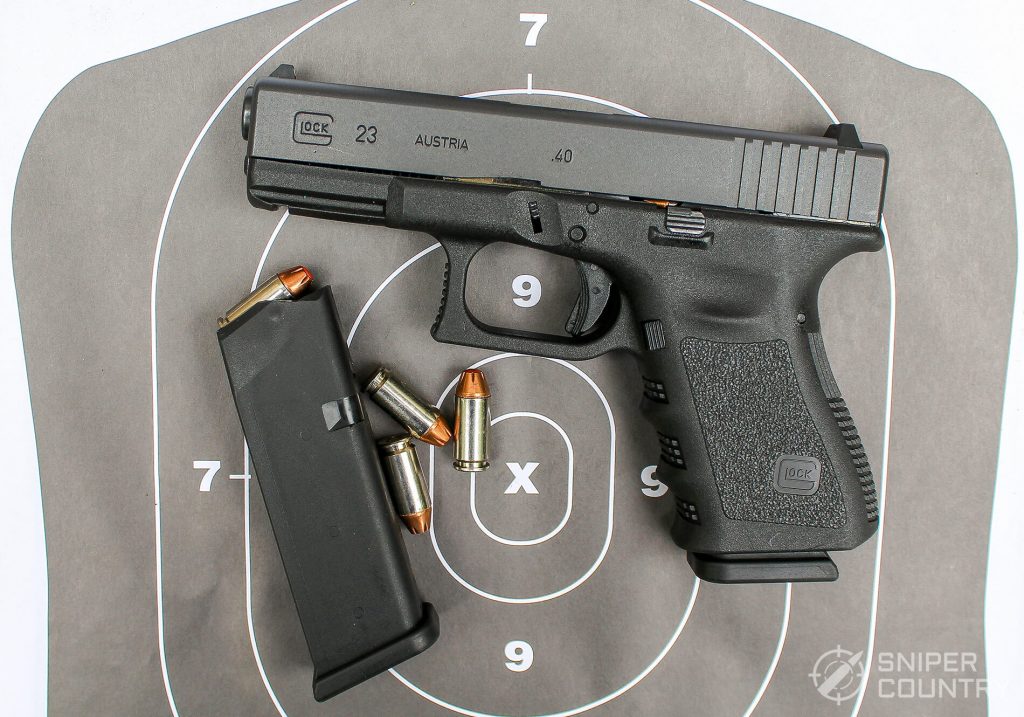
The Verdict up Front
There is a reason the Glock 23 and its larger brother, the Glock 22, have earned ubiquitous adoption among law enforcement. It’s an excellent handgun, and the 40 S&W offers some advantages over the 9mm Glock 19.
The size of the Glock 23 makes concealed carry a breeze. Aftermarket support options for holsters and accessories are bountiful. If you want a Glock 19-sized handgun but desire a more potent round, the Glock 23 is a worthy consideration.
The .40 S&W: A Little History
Where did it come from? The .40 S&W originated when the FBI (who had adopted the 10mm cartridge) asked Smith & Wesson to download the 10mm a bit. The full-bore 10mm was a real handful and so they wanted something that more agents could shoot effectively. S&W created the .40 that bears its name by shortening the 10mm case and downloading it a bit, and the FBI adopted it. For a more complete backstory on the .40, read my handgun cartridge comparison.
It is rather interesting, especially if you’re a forty-fan. To be honest, I have never owned a .40 pistol or carbine. I have nothing against the round — it’s just that I shoot, cast bullets for, and reload the 9mm and .45 ACP. I’ve not seen the need to go with a .40 since I own the “bookends” surrounding it on the caliber shelf. I have often thought of getting a .40 and may do so in the future. If I do, reloading dies, and a bullet mold would be next on the list.
Capacity, Or Lack Thereof
Toting a gun that dispenses right at 400 (or more) foot-pounds of energy would tend to give one confidence. This is true, especially if that gun was not large, was easy to carry and held a dozen or more rounds in its magazine. I think part of the downfall of the .40 is that 9mm cartridge’s ballistic development has really taken off. Also, there are some pretty spiffy 9mm loads out there now that deliver foot-pounds of energy like Hostess Twinkies deliver calories.
Given that you can carry more 9mm ammo in a defined space than you can .40 ammo, that makes a difference. Look at the 9mm compact pistol market leader that most others are compared with — Glock’s best-selling model 19. This is a gun that is basically the same size as our model 23 but can carry two more rounds in its standard magazine than the 23, 15 rounds to 13.
Here, we see the same discrepancy when we look at the full-size Glocks in 9mm and 40, the models 17 and 22 respectively. Model 17 holds 17 rounds in its standard magazine vs. 15 .40 rounds in model 22.
This is not exactly earth-shaking, but to some folks it makes a difference. Some folks carry 5-shot J-frame revolvers — they seem to not be worried about capacity. If you know where to place your shots, that can make up for lower cartridge capacities.
Going the other way, though, reveals that the .40 S&W magazine you have in your pistol will hold one or more rounds than a .45 ACP gun of similar size. Using the same magazine comparison as above, the full-size Glock model 22 in .40 holds two more rounds in its standard magazine than the full-size Glock model 21 in .45 ACP holds, 15 to 13.
Being a .45 fan, this is not exactly comforting news, but (as the saying goes), it is what it is. What it comes down to for me is that It is amazing that you can have even 13 .45 ACP rounds available in your carry gun, not counting extra magazines and the one in the chamber. Capacity plays a big part in caliber selection. But the .40 is still a good choice. It’s right in the middle between the 9mm and the .45 ACP and, as Goldilocks found out, the middle can be the best place to be.
Caliber Compatibility
One thing that you may not think of right off the bat where the 23 is concerned is caliber compatibility. If you buy a .357 Sig barrel for your model 23, you now have a gun in that caliber. Your .40 caliber magazines should work, since the .357 Sig is based on the .40 case.
Worst case, the follower configuration might cause a feeding issue, so you’d need to pick up a model 32 magazine. Another caliber that the 23 is easily converted to is 9mm. Buy a conversion barrel for a hundred bucks or so and a couple of model 19 magazines and you’re now in the 9mm business with what essentially becomes a model 19 that says “23” on the slide. So, you could conceivably have three guns for the price of one initial gun purchase and some after-market parts.
If the ease of changing calibers isn’t enough to make the 23 attractive, I don’t know what will. That’s a pretty interesting capability though — one gun, three calibers.
Popular Articles
Glock 23 Recoil & The 10mm’s Influence
The .40 will let you know you’re not shooting a 22. Its recoil is usually described as snappy, especially in a lighter pistol. If we remember that the .40 is the descendant of the 10mm, its snappiness is explainable. When you push a 180-grain bullet to velocities just south of 1000 fps, then you will get some pushback with regards to recoil.
You’re talking right at 400 ft/ lbs of energy, like some lower-end .357 Magnum loads. I mentioned above how this round is deer-legal in my state, and I guess I can see why. The 10mm will do all things better than the .40 when it comes to hunting, but in terms of concealed carry and personal defense (read more about self-defense insurance), I can see where the .40 has the advantage over the 10mm.
The 10mm truly has some snappy recoil (at least the ones I’ve shot have) which makes it harder to recover from on time. It tends to make follow-up shots harder to execute in any kind of fast, timer-stopping way. I know that there are some of you out there who routinely shoot the 10mm and are perfectly fine with its recoil, but for the majority of us shooters, it’s a handful.
Now we see the connection between the 10mm and the .40 S&W in recoil. The 10 will have more, but the .40 in a light gun will also get your attention.
The Glock 23 and the .40
The .40 S&W out of the 23 can be a bit of handful in its own right. I shot just one load, a 180-grain FMJ truncated cone bullet at right at 990 fps from SIG Sauer. This is a decent training load, one that will help you acclimate yourself to the way the .40 feels when you fire it. True defense ammo is going to be even more energetic. And your shooting hand will learn the difference really quickly.
If you carry a .40, you owe it to yourself to train diligently with different loads that are self-defense oriented. And, don’t shoot one magazine full and then head home. The .40 needs a little extra work in the practice department due to its greater recoil over the 9mm. But if you devote the time, you will have accomplished something that not a whole of shooters do — tame the .40 enough to carry it.
Now, please don’t get the impression that I think the .40 is overkill. It’s just that it takes a little more time to be proficient with it when you shoot it out of a smaller-type pistol, such as the Glock 23. It is well worth the effort to master the gun, though.
This 23 seemed accurate, given the tiny amount of shooting that I did with it. I’ve said it before — Glocks tend to be better-than-average-accurate.
The Glock 23
The 23 is just a bit smaller than the 22, with a minus-two capacity in its magazine compared to the 22. So, it can be a good choice for a concealed carry gun. Its standard capacity of 13 rounds makes it more than plenty for most situations, and its small design strikes a solid balance between full-size and subcompact pistols. You have a smaller gun than the full-size if you do carry it, but you can always use the full-size magazines if you choose — they just might stick out a bit. Still, it’s a simple yet dependable and accurate .40 small pistol option.
The model 23 we have here is a Gen 3. If you are not familiar with the different Glock generations, please go to my Glock 9mm pistol comparison article where I explained the differences.
Glock 23 Specs
Let’s look at the specs of the Glock 23. The gun we’re looking at is a Gen 3 model. The Gen 4 model typically goes for the same price and is generally available. Although availability during these crazy no-guns, no-ammo times is by no means certain.
| Caliber: | .40 Smith & Wesson |
| Action: | Semi-automatic, Glock Safe Action |
| Trigger Pull: | 5 lbs, 6 oz. (my measurement) |
| Capacity: | 13+1 |
| Width: | 1.26" |
| Barrel length: | 4.02" |
| Slide finish: | Tenifer |
| Frame: | Black polymer with duty finish |
| Grips: | Polymer |
| Sights: | Fixed, plastic |
| Rifling: | RH, hexagonal, 1 in 10" twist |
| Overall length: | 7.36" |
| Height (including mag): | 5.04" |
| Weight: | empty, 20.4 oz.; with full magazine, 29.8 oz. (my measurements) |
| MSRP: | $599 |
| Real-World Price: | $500 (price accurate at the time of writing) |
Photos of the Glock 23 Pistol
Now, let’s look at a few photos. I didn’t take nearly as many photos of this gun as I have for past Glock reviews because (excepting generational differences) if you’ve seen one Glock, you’ve pretty much seen them all.
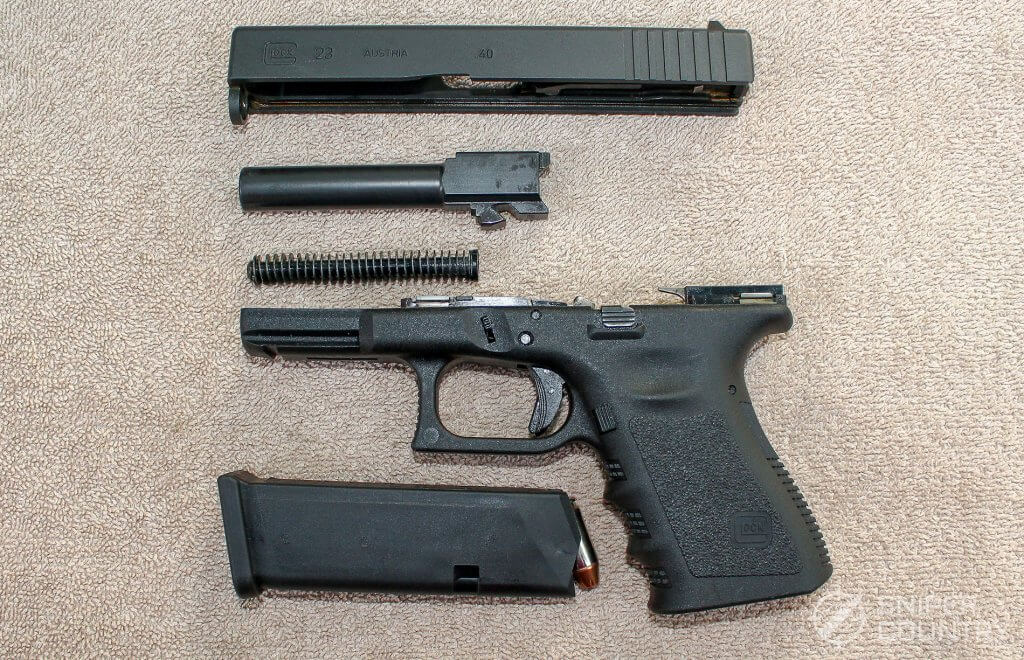

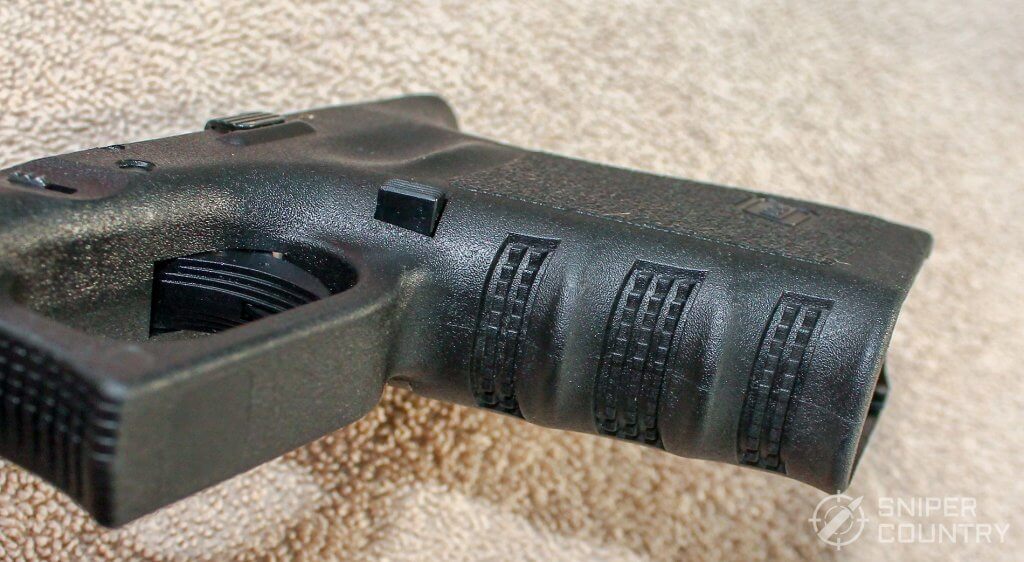
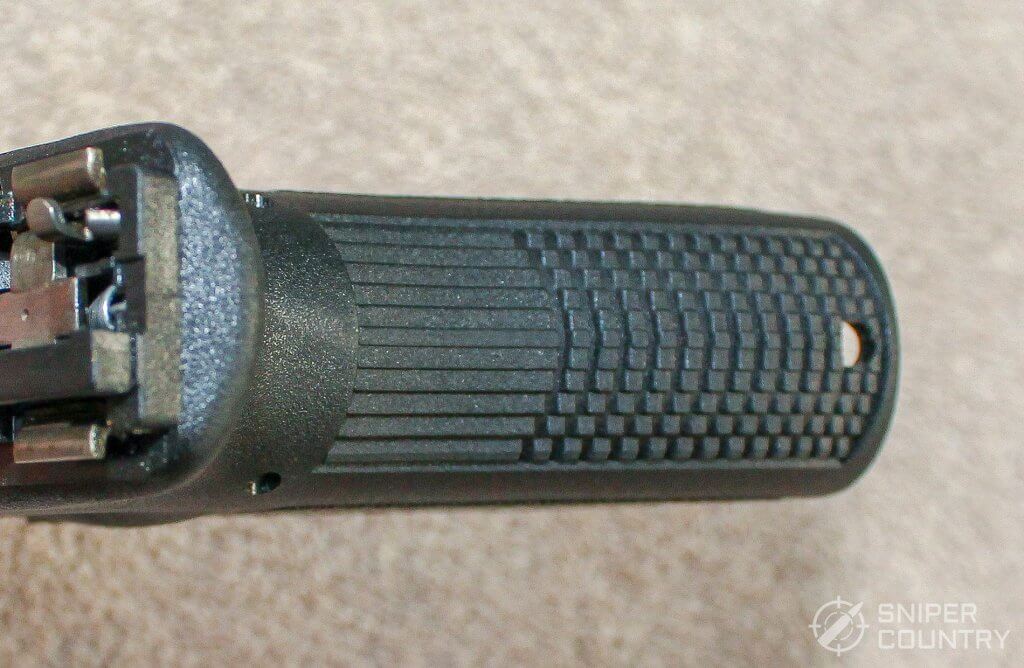
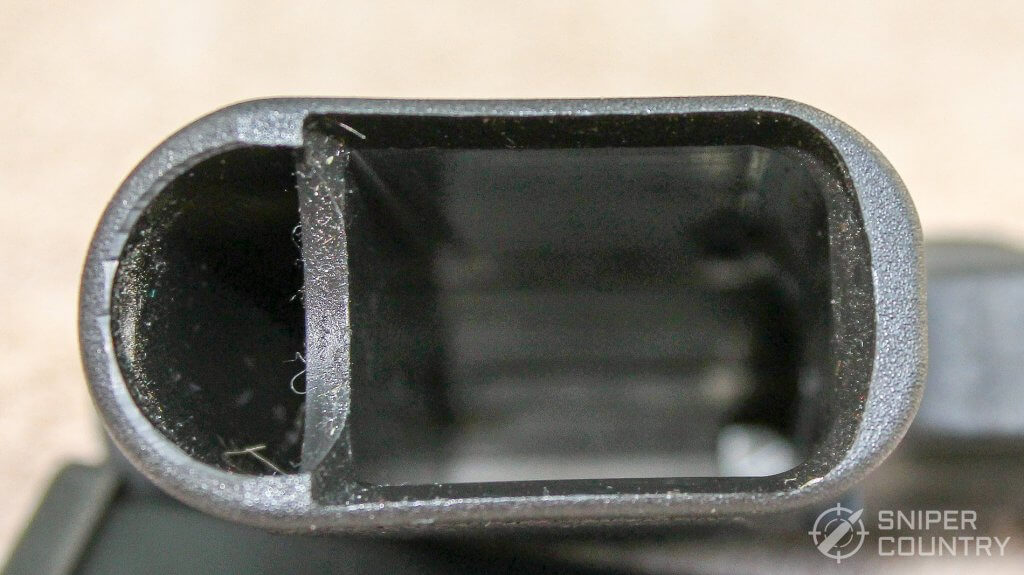
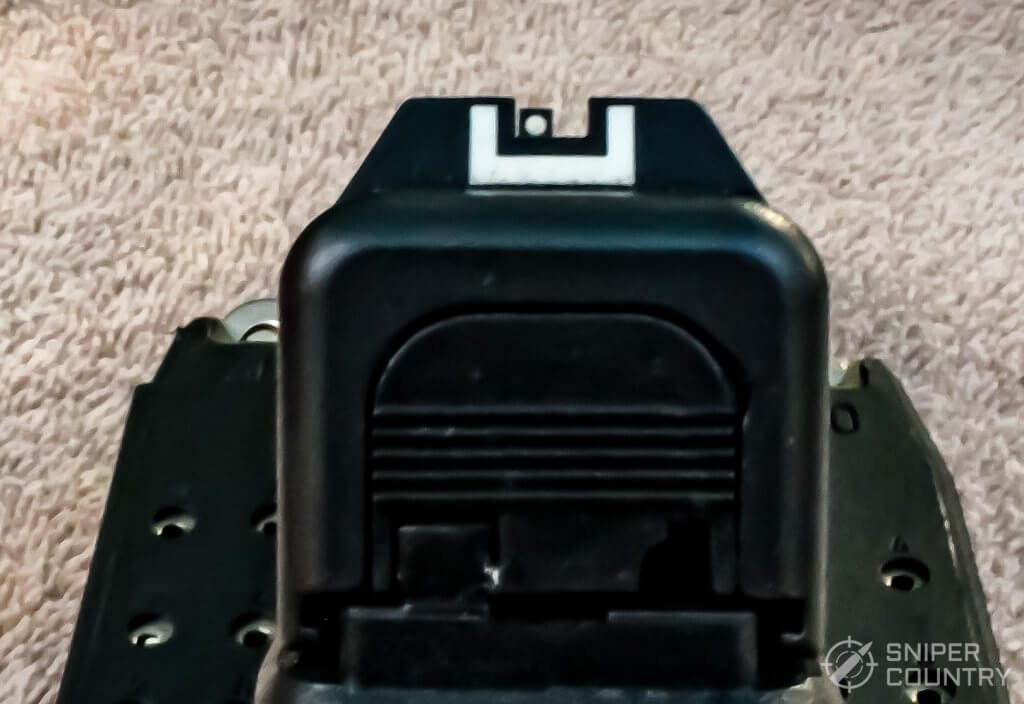
Cup-and-saucer, football-and-goalpost — whatever you call the sights, some folks love them while others — not so much.


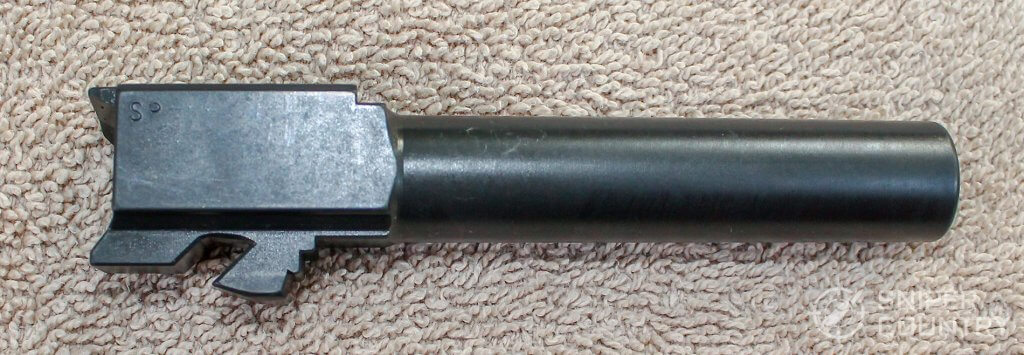
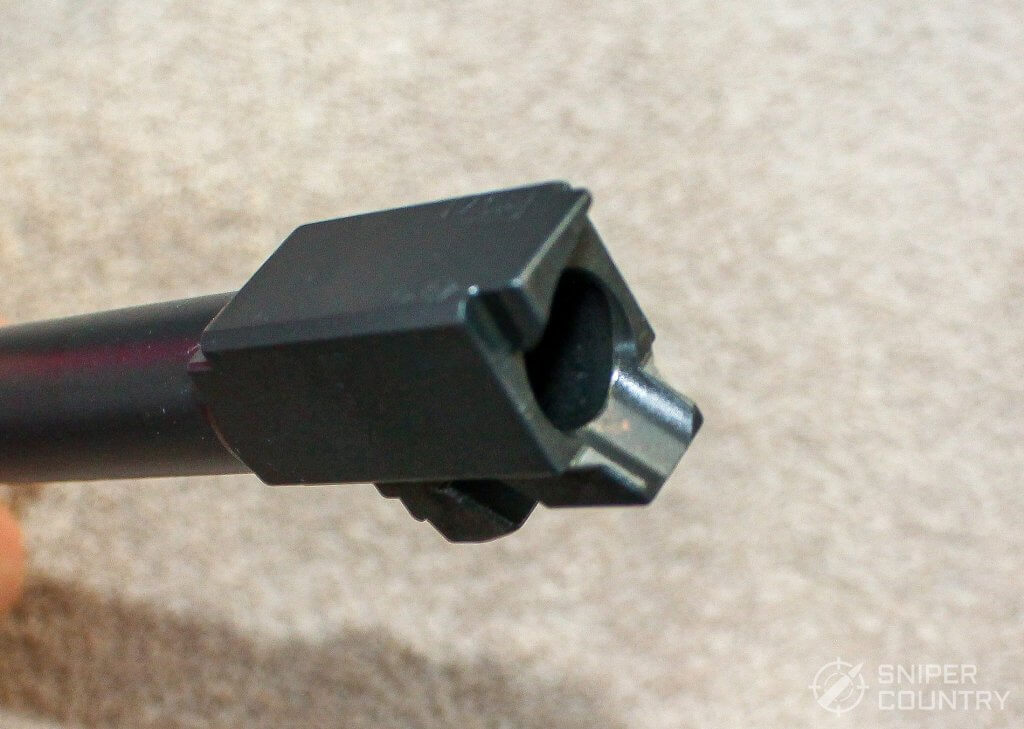
And, lastly, the magazines. In case you forget what caliber you’re shooting, just look at the mag.
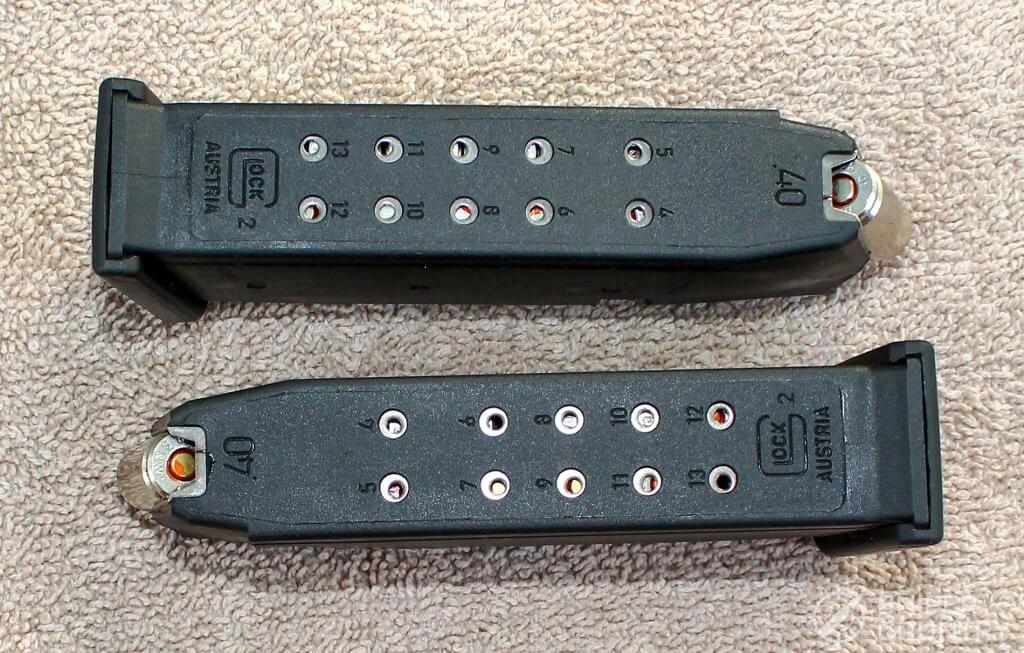
Glock 23 Performance
Shooting the Glock 23
This ammo shortage is really starting to hit home. I’m a reloader, but as I said above I do not load .40 S&W. I happened to have one partial box of 180-grain FMJ loads from SIG Sauer, so I shot exactly five of those. Here’s the target.
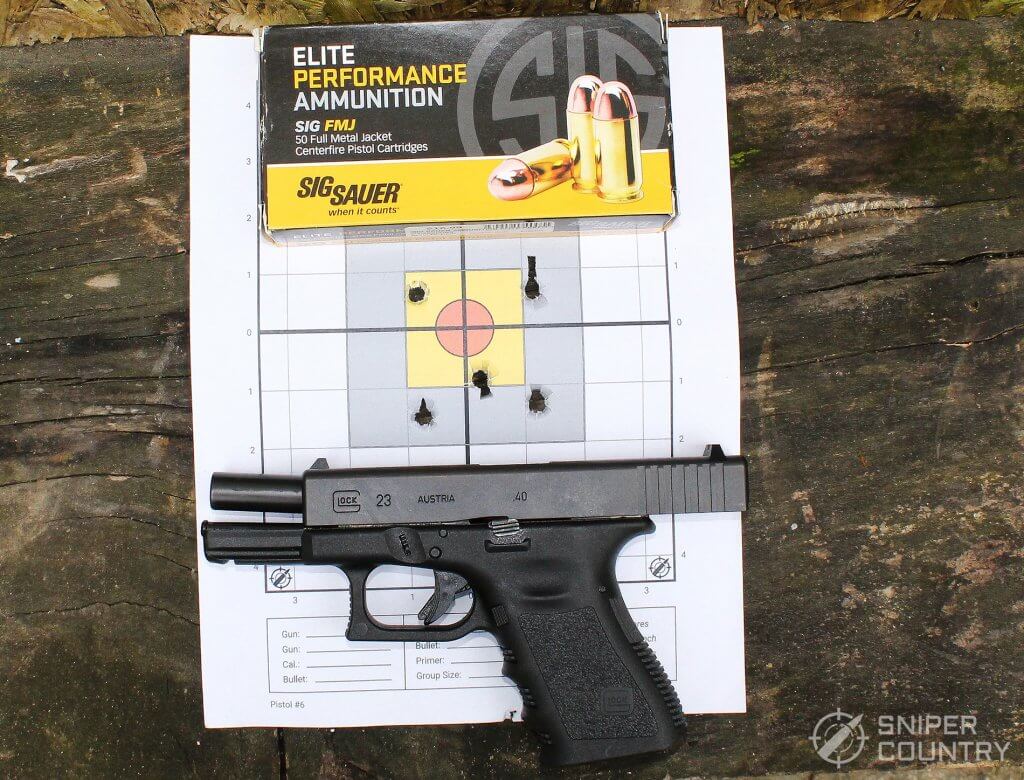
As you can see, the rounds landed pretty much where I wanted them to, if not in a tight little group (the squares on my target are one inch). This was shot from my bench at around 20 yards. At least they’re in the black square. I used a center combat hold. As with every target I present in my reviews, I remind readers that I am not exactly Camp Perry material when it comes to shooting.
I can get the job done as I’ve taken more than a few deer with handguns, some pretty far out there. Sometimes I shoot better than others. At any rate, this is a Glock — they tend to be accurate, repeatedly. We are reinventing the wheel here. I’m not proving anything or offering anything new. I was just having a bit of fun shooting a gun that produces a good, hearty BANG when you press the trigger, even if I only did it five times.
Glock 23 Fit and Feel
The grip is as blocky as the grips on most other Glocks, making it uncomfortable to hold for long periods. Those who are younger and more accustomed to shooting with polymer-framed, double-stack handguns will find the grip comfortable. The rectangular shape of the grip makes it difficult to reach the trigger, especially for those with larger hands.
The magazine release cannot be switched around unless you have a Gen 5 model. For some, that’s a dealbreaker. Another problem is that the sliding release is only on the left side. The good news is that Glock fixed both of these problems with the Gen 5 models and added a second backstrap to make the gun even more comfortable to hold.
Who is the Glock 23 For?
Since the .40 is commonly used by law enforcement, we can safely assume that self-defense is its primary civilian function. One of the most common platforms for that caliber and purpose is the Glock 23.
Because of its adaptability, the G23 may be Glock’s most popular .40 caliber handgun among civilians, just like the G19 is the company’s best-selling 9mm. Because it is a Glock, shooters know it is a high-quality pistol with a proven track record of accuracy.
Wrap Up
So, we reach the end of our little stroll down Glock Lane. I could see carrying the model 23 in an IWB holster. Given 13 rounds of .40 S&W (plus another 13 in an extra mag), I would feel protected. My only suggestion to those who want to carry one is to practice — a lot. Practice with the same bullet weight as that your carry ammo uses. That way, the impact point between both loads should be very close.
The .40 can be snappy (the current buzzword used to describe .40 S&W recoil), so practice is essential. If you own one, please chime in below. Let us hear from you. As always, keep them in the black and stay safe.
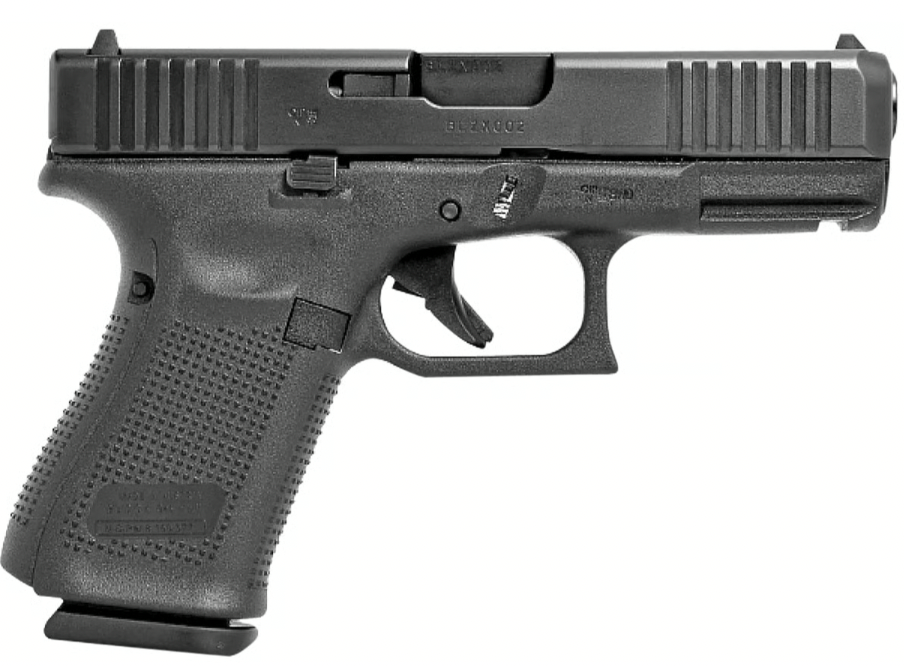
Other readings you might also enjoy:
- Best .40 S&W Ammo: Self Defense & Target Practice
- The 4 Best Glock Speed Loaders
- Glock 43 Review: Ultimate Concealed Carry Gun
FAQ
The Glock 23 costs between $400-600 depending on generation and model. Gen 5 MOS versions being the most expensive and Gen 3s the cheapest.
The Glock 23 is a .40 caliber pistol chambered in .40 S&W.
The standard Glock 23 magazine holds 13 rounds. Optional magazines are available that hold 14, 15, 16, and 22 rounds.
The Glock 23 is a compact pistol chambered in 40 S&W. Is it the same size as a Glock 19, only chambered in a different caliber.
The frames of the Glock 19 and Glock 23 are identical. The only difference is that the Glock 23 is chambered in 40 S&W while the Glock 19 is 9mm.
Yes, the Glock 23 is a well-proven handgun and retains all the reliability and accuracy Glocks are known for.

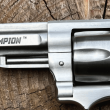
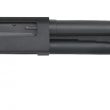
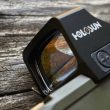
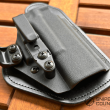
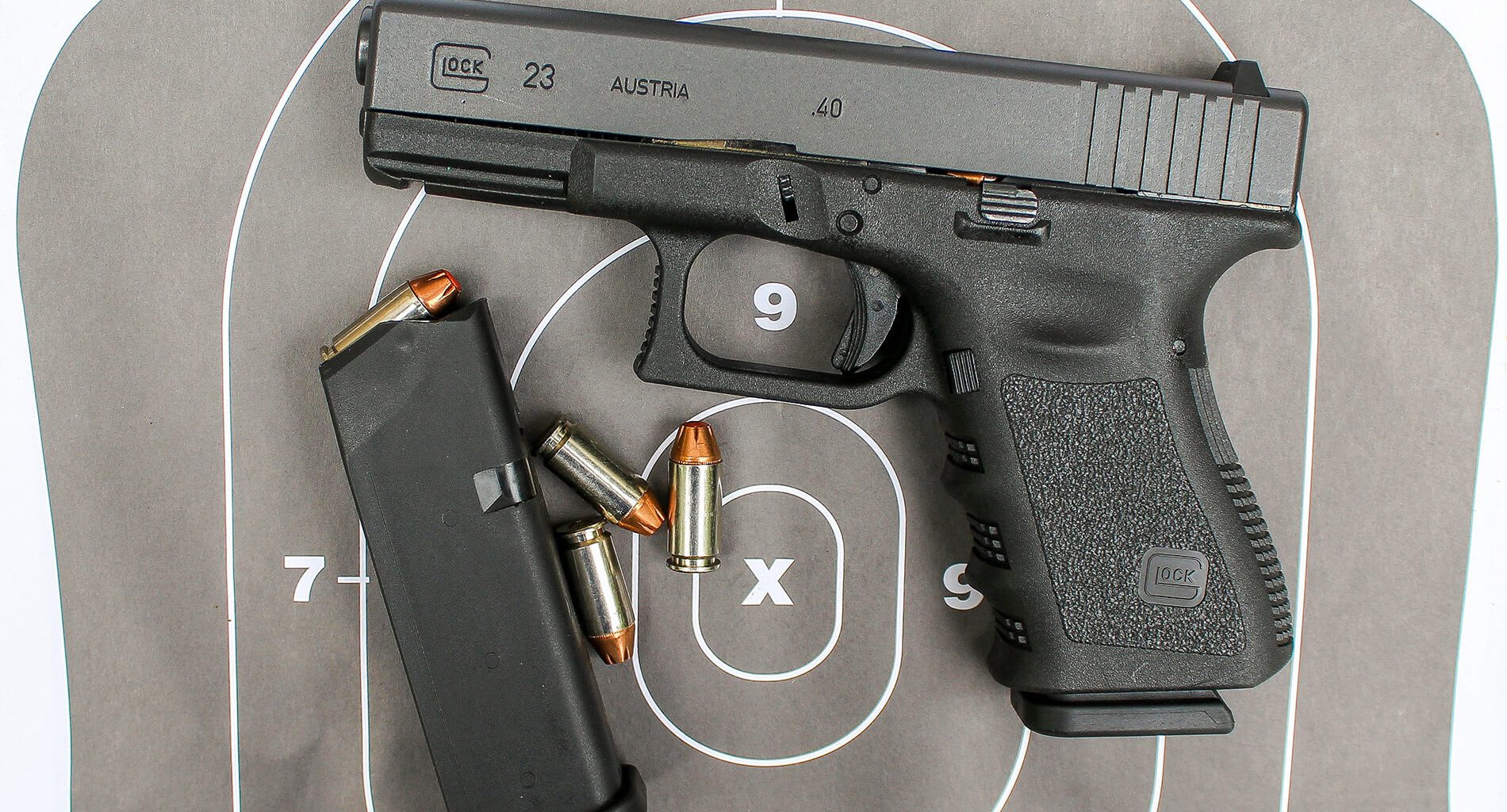
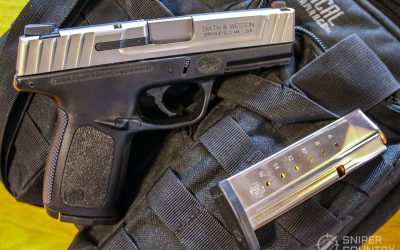
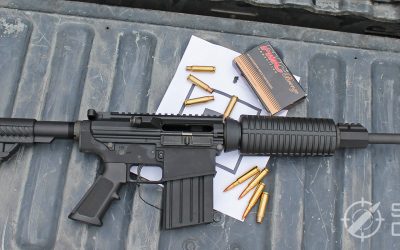
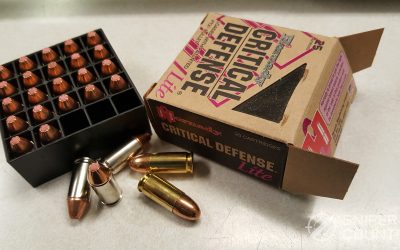
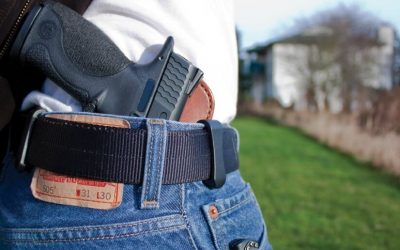
![9mm Glock Models [Ultimate Guide]](http://161.35.252.213/wp-content/uploads/2018/10/Glock-17-vs-Glock-19-vs-Glock-26-vs-Glock-41-vs-Glock-43-WM-400x250.jpg)
![Handgun Caliber Chart [2025 Ultimate Guide]](http://161.35.252.213/wp-content/uploads/2018/10/Handgun-Caliber-Comparison-400x250.jpg)
![Rifle Calibers [Ultimate Guide]](http://161.35.252.213/wp-content/uploads/2018/12/Header-1900-400x250.jpg)
